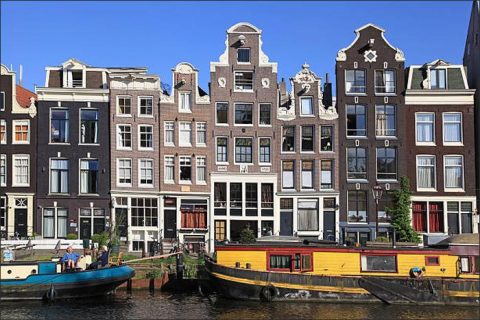It would be altogether too facile to regard the various anti-Rationalist tendencies of 1914-23 as a revolt against the mainstream of development, or as a serious alternative ‘school’ to the emergent International Style. Though Twentieth-century architecture was undoubtedly impoverished formally by the demise of this manner of design, the resolute paring-down to one particular set of formal and structural solutions that took place in the early Twenties seems to have been a necessary phase of self-discipline and brain-cleansing before development could resume.
It would, indeed, be better to regard Wendingen and Expressionist architecture as late outcroppings of attitudes to design that had been part of the main body of European architecture before 1914, but became increasingly unacceptable on formal grounds after 1918. And it should be emphasised that despite the tentative alliance of Amsterdam and Berlin in 1919, they were separate developments both in origin and character.
Since Amsterdam possesses the larger body of work, done over more than a decade, and was the instigator of the short-lived alliance, it will be dealt with first. The chief ornament of the school was Michel de Klerk ( 18841923) as already mentioned, and he, with Piet Kramer, the next most brilliant member of the Amsterdam school, did much of the detailing and interior work on van der Mey Scheepvaartshuis in 1913. There, and at de Klerk’s independent Hillehuis two years earlier, one can see emerging a distinctive style that might be called twentieth-century in accent, unrestrainedly eclectic in vocabulary, but nineteenth-century in its phraseology.
Indeed the Hillehuis follows structural precepts that go back even further in Dutch town-house practice, but the Scheepvaartshuis follows, more or less, the structural precedents worked out in Berlage’s office-buildings before the turn of the century. However, where Berlage’s structures tend to be invested in a kind of neutralised Romanesque detailing by the time he came to design the Beurs, the detailing of these two pioneer works of the Amsterdam school is far from neutral in tone, and draws from a variety of sources, including Art Nouveau in general and Toorop in particular,
Expressionist painting and carving, de Groot’s mathematical exercises, from Berlage himself, and from Wright. As J. J. P. Oud observed at different times these last two are to be accounted the more important influences on the style, and this probably accounts for the strain of interest in exhibited structure (or pseudo-structure) that runs right through the decade of the school’s greatest activity, also the tendency to use commonplace materials, like brick, tile-hanging and wood, in a manner that shows genuine affection, and such as Berlage could hardly have disapproved. Thus, on the Scheepvaartshuis, structural corbels made from several pieces of stone are allowed to appear, in spite of elaborate figurative carving, as corbels carved from several pieces of stone.
Examples of this kind could be multiplied throughout the work of the school, and they emphasise the right of de Klerk and his connection to be regarded as the true heirs of certain aspects of Berlage and Wright, just as much as J. J. P. Oud and his connection were the heirs of other aspects. It was, no doubt, this common heritage that made it possible for Jan Wils, for instance, to pass from one side to the other without ceasing to write admiringly of Wright, and also made it possible for the Amsterdam and Rotterdam schools to fuse fairly painlessly into a national style once de Klerk was dead and van Doesburg was out of the country–though the process was no doubt facilitated by the existence, around 1925, of independent Wright/Berlagians like Willem Marinus Dudok, who subsequently became the hero-figure of middle-ofthe-road Modernists.
However, the main characteristics of the Amsterdam School all lie in the direction of the physical manipulation of the building in the course of erection, rather than in intellectual decisions made beforehand: its vital expression is in its detailing, which is often representational and therefore its history is iconographical, rather than theoretical, and lies outside the scope of the present study.
However, it served a useful irritant function in other people’s theoretical writings, and not only acted as a standing example of individualistic licentiousness at which the moralists of de Stijl could point the finger of scorn, but also drew their attention to things that they might otherwise have missed in the work of Frank Lloyd Wright, for instance. Thus Oud, noting the misuse of Wright’s example in Europe, draws attention to a vital aspect of his work that escaped comment elsewhere, and to which his own attention was almost certainly directed by the contrast between Amsterdam architecture and that of his own ‘Cubist’ connection.
That which in Cubism–and it cannot be otherwise–is puritanical asceticism, spiritual self-denial, is with Wright exuberant plasticity, sensuous superfluity. What arises in Wright from the fullness of life to a degree of luxury that could only fit into an American ‘High-life’, withdraws in Europe to abstraction that derives from other ideals and embraces all men and everything.
Hits: 100
